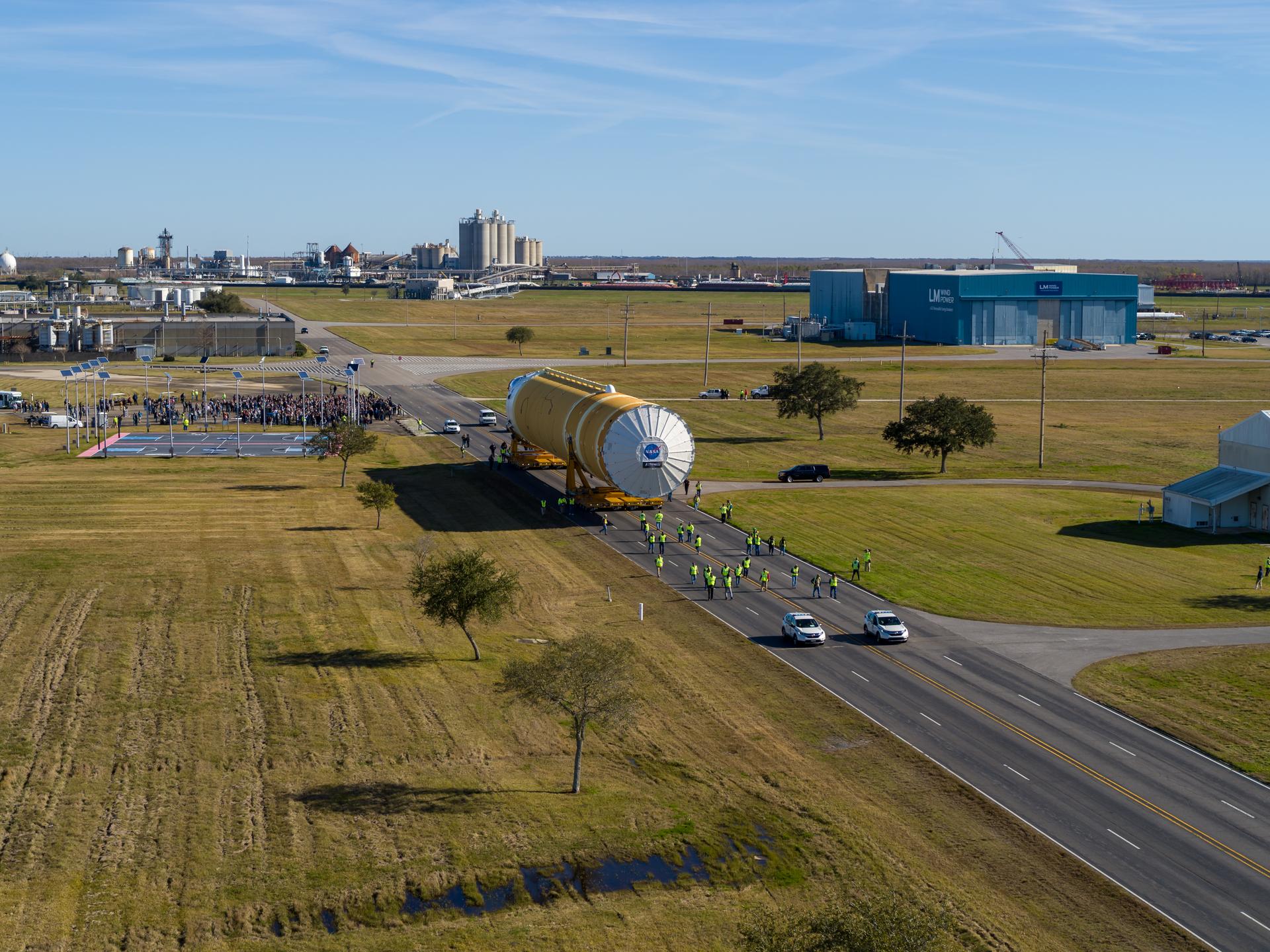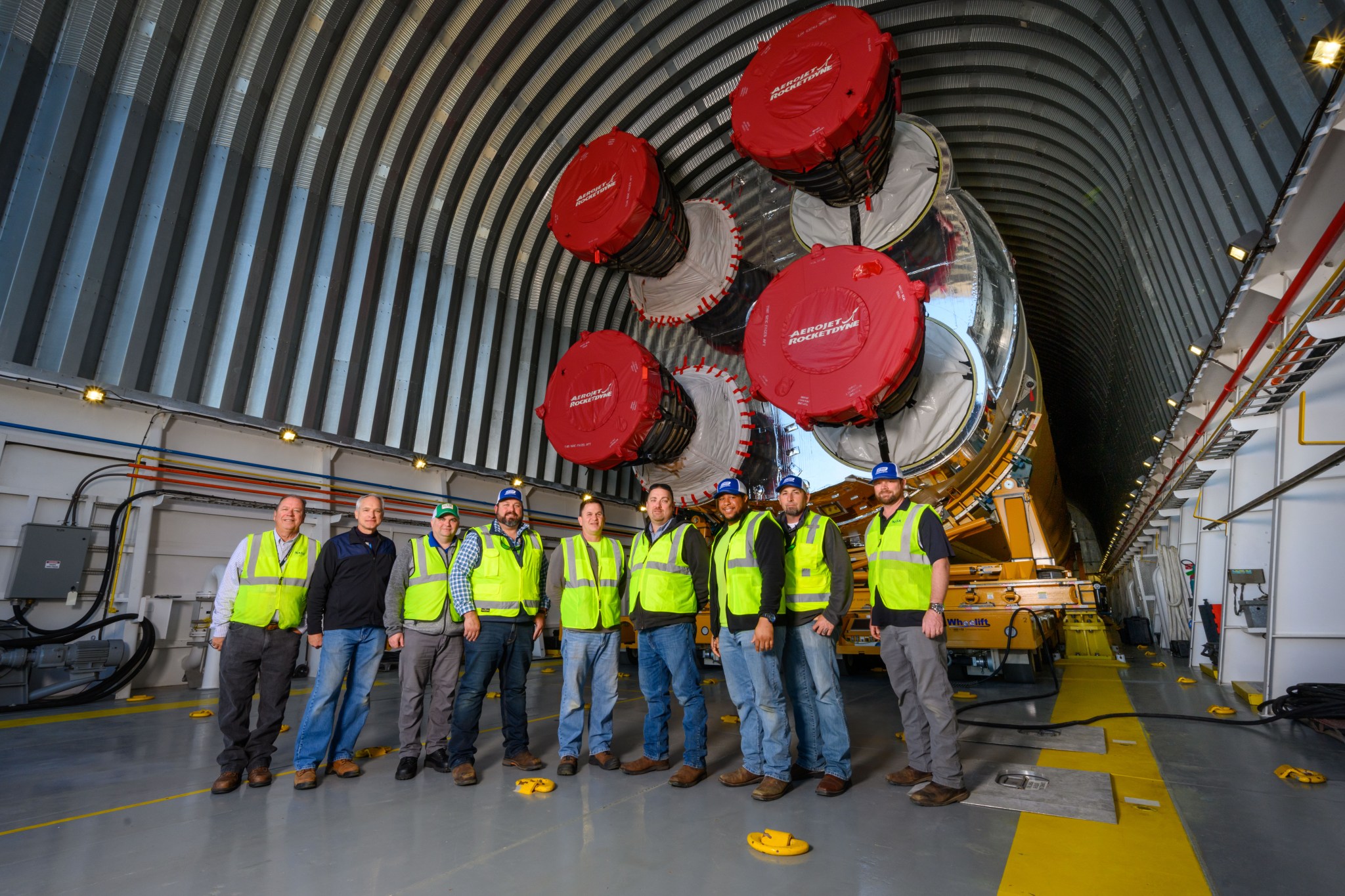As NASA prepares for the first launch of Artemis I, the first mission of the agency’s Space Launch System (SLS) rocket and Orion spacecraft to the Moon, one team will be there every step of the way: the aptly nicknamed “SLS Move Team.”
Based out of NASA’s Marshall Space Flight Center in Huntsville, Alabama, the move team ensures all the flight hardware for the SLS rocket’s core stage is safely and efficiently transported from the site where it was manufactured to various test facilities and — ultimately — to its future launch site. From the very beginning, the move team has been an integral part of the SLS Program.
“Marshall’s Ground and Marine Transportation teams are responsible for the handling and transportation of the SLS rocket’s core stage, which is the largest rocket stage NASA has assembled, tested and transported since the Apollo Program,” said Robert Rutherford, transportation and logistics engineering group lead at Marshall. “We started logistics planning for both the moves of structural test articles of the individual elements and for the entire Artemis I core stage early on in the program.”

While the full team is divided between ground and marine activities, together they typically operate as one cohesive unit to successfully transport the large hardware for the megarocket’s 212-foot-tall core stage. The huge stage includes two giant propellant tanks and four RS-25 engines, each the size of a compact car.
The teams’ coordination and efforts were prominently displayed as the first SLS rocket core stage was rolled out from NASA’s Michoud Assembly Facility in New Orleans to the agency’s Pegasus barge on Jan. 8, then transported by Pegasus from New Orleans to nearby NASA’s Stennis Space Center near Bay St. Louis, Mississippi, for the core stage Green Run test series. Once the barge and flight hardware arrived at Stennis, the Ground Operations team was again at work, helping to prepare, lift and install the flight hardware into the B-2 Test Stand for the test campaign.
“The effort to move the SLS rocket’s core stage from Michoud to Stennis and installing it into the B-2 Test Stand is a result of extensive preparation,” said Bryan Jones, logistics engineering and ground transportation team lead at Marshall. “It was a true team effort. Without the support of all parties that play a part in the operations, we would not be able to be successful.”

The Ground and Marine Transportation teams have been vital in shipping four structural test articles from Michoud to Marshall for testing. The teams prepared for the move of actual flight hardware with SLS pathfinders during the spring and summer of 2019.
The ground and marine teams spend months meticulously planning and developing detailed transportation move procedures to ensure test articles and flight hardware alike are delivered without a mishap. They use a myriad of specialized equipment, including transporters specifically designed to accommodate and hold the hardware, and Pegasus.
The now 310-foot-long barge was modified and refurbished in 2015 to successfully ferry the SLS core stage, which is more than 50 feet longer than the space shuttle external tank and – when including ground support and transportation equipment — more than 600,000 pounds heavier. The shuttle’s external tanks were frequent passengers aboard Pegasus during the shuttle era of space exploration.
“Each member of the team understands the privilege and responsibility that NASA’s ground and marine transportation teams have been given in handling hardware that will enable the United States to send American astronauts to the Moon and on to Mars,” said Alan Murphy, team lead of marine operations for Pegasus. “The key to preparation for the Pegasus crew is in the vessel itself. Pegasus has the capacity to carry each of the individual core stage elements in addition to the actual core stage.
The size of the SLS core stage pathfinder and the flight hardware core stage, although massive, did not intimidate the Pegasus crew as we leaned on our experience from shipping the four structural test articles,” he added.
Like their counterparts in ground transportation, the Pegasus crew prepared to ship the larger, much heavier fully assembled core stage by delivering structural test articles and pathfinders to different NASA centers. Pegasus made the first delivery of the Artemis program to NASA’s Kennedy Space Center in Florida with the core stage pathfinder, a full-scale replica of the stage, in September 2019.
The Ground and Marine Transportation teams coordinate their efforts with numerous other NASA organizations and dozens of agencies, including the Tennessee Valley Authority, Corps of Engineers, Coast Guard and National Oceanic and Atmospheric Administration, to get the hardware from one NASA facility to another.
“Before NASA transports any hardware, teams meet to consider every aspect of the move from the strength of the roadways to the weather the day of the move,” Rutherford said. “Because of the SLS core stage’s height, weight, width and length, special combinations and modifications had to be made to roads, docks, even power lines, and to the barge itself, to accommodate the total weight and width of the rocket hardware.”
Hours of work go into planning and executing the various dynamics of transporting, loading and handling the flight hardware. However, the final factor for consideration before any move begins is usually the most unpredictable: the weather. Following the arrival of Pegasus and the core stage for Artemis I to Stennis for the Green Run test series, crews spent several days assessing the wind and rain factors at and above ground level before lifting and installing the rocket stage into the test stand.
While the core stage undergoes Green Run testing at Stennis, Ground and Marine Transportation teams will be at work to ship the launch vehicle stage adapter, the part of the rocket that connects the core stage to the upper part of the rocket. The hardware will move from Marshall, where it is manufactured, on Pegasus to Kennedy, where engineers will prepare it for integration to the rest of the rocket ahead of the launch of Artemis I.
A rocket as large as the SLS rocket doesn’t arrive to the launch pad fully assembled. Teams will assemble, or stack, the various elements and stages of the SLS rocket inside Kennedy’s Vehicle Assembly Building before moving the fully assembled rocket to the launch pad. As they have done since the beginning, the men and women of Marshall’s ground and marine transportation teams will be on hand to plan and carry out the well-orchestrated effort it takes to transport the various pieces of hardware across the country — and waterways — to Kennedy for the first Artemis launch to the Moon.
NASA is working to land the first woman and the next man on the Moon by 2024. SLS, along with Orion, the human landing system, and the Gateway in orbit around the Moon, are NASA’s backbone for deep space exploration. SLS is the only rocket that can send Orion, astronauts and supplies to the Moon on a single mission.
For more on NASA’s SLS, visit:
Tracy McMahan
Marshall Space Flight Center, Huntsville, Alabama
256-544-0034
tracy.mcmahan@nasa.gov

























